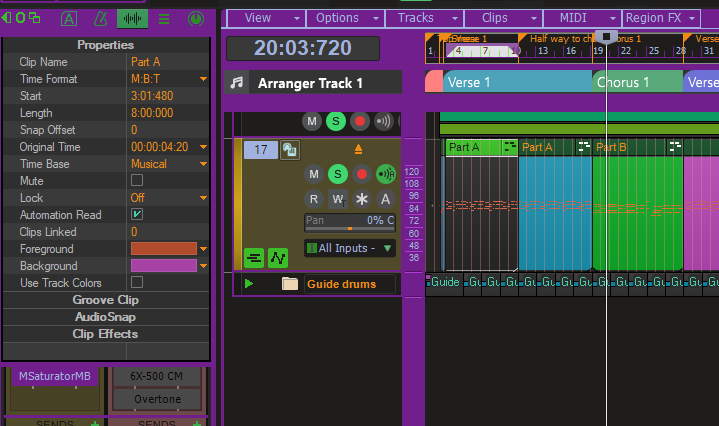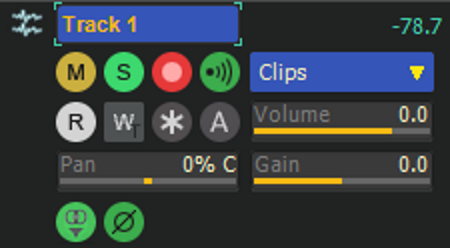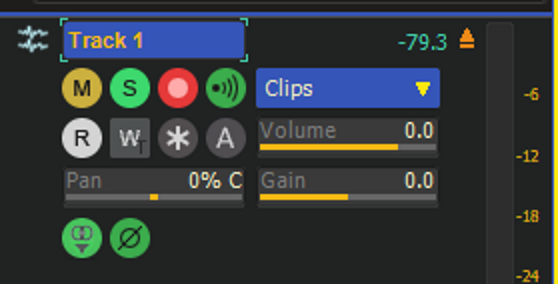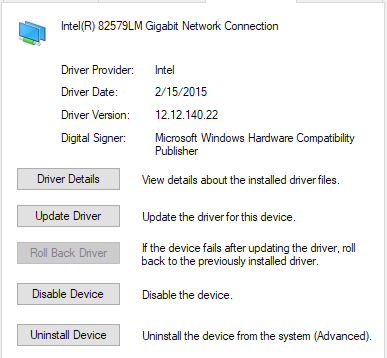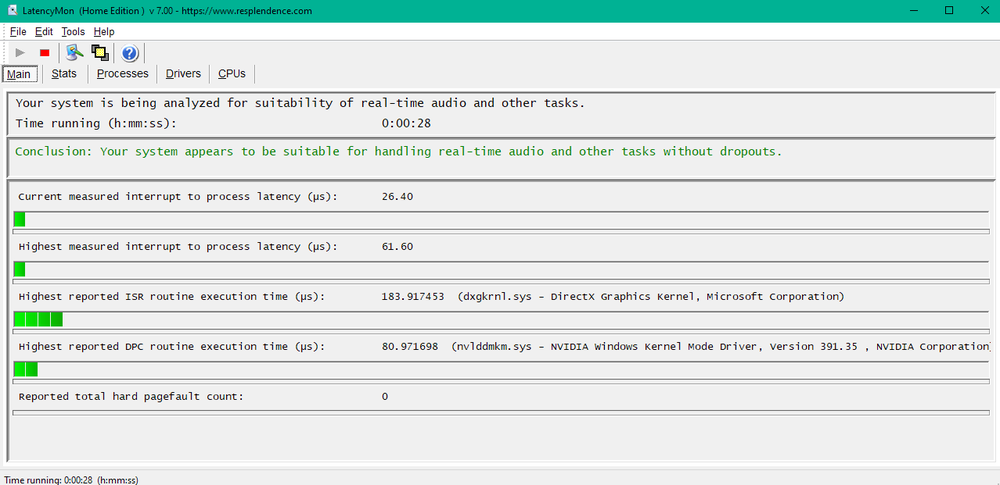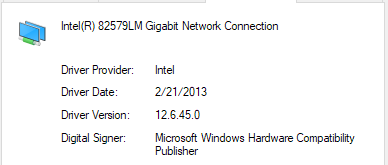-
Posts
8,620 -
Joined
-
Last visited
-
Days Won
30
Everything posted by Starship Krupa
-
TBProAudio make a freeware loudness meter that is a powerhouse, dpMeter5. There's also one in the Meldaproduction FreeFX Bundle. I'm trying to understand this process. When you say you tried using the "W" feature, do you mean you tried to write automation for EQ and Maximizer parameters in real time, but your computer couldn't handle it? It sounds like you're doing might also be accomplished with track freezing? Maybe not, I'm not sure exactly why you need to take the files outside Cakewalk then bring them back in to do this.
- 13 replies
-
- izotopw
- www.baselines.com
-
(and 1 more)
Tagged with:
-
(note: I'm not using the metronome and there are also 0 count-in measures set, so I'm pretty certain that's not the issue) Scenario is that I'm trying to punch in a chorus, recording a sustained block chord organ part to MIDI. The chorus begins at measure 19 so I set my punch-in to 19:01:000. Chorus ends at measure 29, so I set my punch-out to 30:01:000 to give myself a bit of overlap if necessary. I'm also looping it, and set my loop points to 17:01:000 and 30:01:000. Starting early so that I can drop into the groove and ending late in case I need to overlap. What's happening is that I start playing, but my playing doesn't start getting recorded until I get a full measure into the chorus. What I suspect is causing this is that I'm playing sustained notes and am rushing (see "not using the metronome" above), so starting them before the punch-in. Although I can hear notes sounding, my note-ons aren't getting recorded; it's not until I lift and go to the next chord that it sees note-ons. Sound likely? If that's the issue, let this function as a public service announcement: when punching in a MIDI performance, set your punch point a quarter note or so ahead of where you think you're going to start playing so that sustained notes don't get lost.
-
Perhaps not though, I have a memory that it was completely eliminated a couple of years back and then was returned for the Smart and Move tools after protests from the userbase. I don't remember why it's only for those two tools, of if there was a reason.
-
Something that has long bothered me is how when I have View/Show Clip Outlines enabled in the Piano Roll View, there would be shading for clips, but no indication where one clip left off and the other started. By accident, I discovered a way to tell clips on the same track apart from each other. It may be obvious to others, but it took me 3 years of using this program to stumble on it, so maybe not everyone knows. First, ain't this lovely? That's a single track with the clips showing up in different colors. Great for working with linked clips or just to know where one leaves off and the other starts. How to do it? It's the Inspector. Just select the clip you want to color, open the Inspector, click on the "Clip" tab at the top, and choose a Background color. The background color you choose for each clip will show up in the Piano Roll View. That's all there is to it. It may look a little different on your screen depending on whether you're using a custom theme. My themes use dark backgrounds for selected clips. I hope this helps someone, it's really helped me with keeping track of clips in the PRV. It also helps distinguish them in Track View. Foreground color will change the color of the data, or events in the clips but only in Track View.
- 1 reply
-
- 3
-

-

Waveform outlines serve no practical purpose!
Starship Krupa replied to Bill Ruys's topic in Cakewalk by BandLab
They do look effn' cool, and that's a good thing for when someone's looking over your shoulder and wondering what that intriguing DAW is. Not surprising for someone as into CbB theming as I am, I'm really into how visuals can be inspiring, and this does it. For anyone wondering how to set their colors up, drop into the UI Themes subforum and see what we've worked out with Custom Color sets. Custom Colors is the only way to change the vertical lines in Track View, so it's important and powerful. The standard lines are too faint for my taste. -
BTW @Glenn Stanton, I'm kinda interested to hear what "Watch All The Longtower" sounds like. Makes me wonder if you have a song called "Rock From The Third Sun."
-
I think you mean "set Now Time" in Cakewalk terminology. I'm with you on this. The behavior has changed a bit over the years, but I'm still reflexively clicking down in the whitespace with the wrong tool. I'm not sure what the rationale is for limiting it to the Smart Tool and Move Tool. I'm just as likely (if not more) to want to position the Now Time when I'm using the Select, Edit, and Draw Tools, so why not?
-

Theme: Yellow Submarine (updated for 2021.12)
Starship Krupa replied to Starship Krupa's topic in UI Themes
-

theme Theme: EVA 01 Redux (updated for 2021.12)
Starship Krupa replied to Starship Krupa's topic in UI Themes
EVA 01 has been updated with round buttons (images are from Yellow Submarine, which has been similarly updated): -

documentation Young Lady's Illustrated Primer to Theming Cakewalk
Starship Krupa replied to Colin Nicholls's topic in UI Themes
Even after having done all this testing and writing it up, there's still trial and error. It just started to bug me that my button images for the FX rack didn't match up. My choice for indicating ACT focus would be a simple on/off "light" rather than changing the appearance of half a dozen different images, but I don't think this was designed with end-user theming in mind. It's great that it went that way. -

documentation Young Lady's Illustrated Primer to Theming Cakewalk
Starship Krupa replied to Colin Nicholls's topic in UI Themes
FX Rack gets my nomination for being the section with the most complexity. In addition to the stuff I already went over, there's also the matter of the bypass and show rack buttons on either side, which add 8 images to the stew pot. There are 4 conditions, which are active (no ACT Focus), bypassed (no ACT Focus), active (with ACT Focus), and bypassed (with ACT Focus). Fortunately, their behavior is consistent across all the conditions, for both the Bypass Plug-in and Show Rack Menu Drop-down buttons. One confusing quirk is the naming of the Bypass Plug-in images: The Bypass Plug-in image is used in the plug-in's active state, with no control surface enabled. When the Bypass button is hovered, it uses Cell 3. When the center of the Open UI button is hovered, it uses Cell 1. When the Bypass button is pressed, it uses Cell 2. Confusingly named,, the Bypass Plug-in Enabled image is used when the plug-in is bypassed. The cells are used same as described for Bypass Plug-in above. All other images follow the above behavior: hover button=Cell 3, hover center=Cell 1, pressed=Cell 2. Fortunately there are no curveballs when the center image is pressed. Of course, if you have a controller enabled, if you press the center, all buttons switch over to the ACT Focus versions. What this means in terms of use of the other images is that you can do things like matching the color of the buttons that appear in the center hovered condition. I just poke around at the buttons and see if anything looks jarring. -

documentation Young Lady's Illustrated Primer to Theming Cakewalk
Starship Krupa replied to Colin Nicholls's topic in UI Themes
I just spent some time (time that I will never get back) with the images and colors in FX Rack. Here's what I found. With no control surface enabled and the effect in its active, non-bypassed state Normal: FX Rack/Name Background cell 1 Hovered: FX Rack/Open Plug-in UI cell 3 Pressed: FX Rack/Open Plug-in UI cell 2 Hovering the Bypass or Show Rack Menu button: FX Rack/Open Plug-in UI cell 1 With no control surface enabled and the effect in its bypassed state Normal: FX Rack/Name Background cell 2 Hovered: FX Rack/Open Plug-in UI Bypassed cell 3 Pressed: FX Rack/Open Plug-in UI Bypassed cell 2 Hovering the Bypass or Show Rack Menu button: FX Rack/Open Plug-in UI Bypassed cell 1 This is pretty much as expected. Things get more complicated when we enable a control surface. Once a control surface is enabled, there is another condition a plug-in effect can be in, which is having focus for the purposes of controlling it with the surface. A plug-in gets focus by having its UI opened, and keeps focus until the next plug-in UI is opened. I'll start with a plug-in that does not have what I'll call "ACT Focus." With a control surface enabled and the effect in its active, non-bypassed state Normal: FX Rack/Name Background cell 1 Hovered: FX Rack/Open Plug-in UI cell 3 Pressed: FX Rack/Open Plug-in UI (ACT Focus) cell 2 Hovering the Bypass or Show Rack Menu button: FX Rack/Open Plug-in UI cell 1 With a control surface enabled and the effect in its bypassed state Normal: FX Rack/Name Background cell 2 Hovered: FX Rack/Open Plug-in UI Bypassed cell 3 Pressed: FX Rack/Open Plug-in UI (ACT Focus) cell 2 Hovering the Bypass or Show Rack Menu button: FX Rack/Open Plug-in UI Bypassed cell 1 When the plug-in has ACT Focus, the behavior changes again as follows: With ACT Focus and the effect in its active state Normal: FX Rack/Name Background (ACT Focus) cell 1 Hovered: FX Rack/Open Plug-in UI (ACT Focus) cell 3 Pressed: FX Rack/Open Plug-in UI (ACT Focus) cell 2 Hovering the Bypass or Show Rack Menu button: FX Rack/Open Plug-in UI (ACT Focus) cell 1 With ACT Focus and the effect in its bypassed state Normal: FX Rack/Name Background (ACT Focus) cell 2 Hovered: FX Rack/Open Plug-in UI Bypassed (ACT Focus) cell 3 Pressed: FX Rack/Open Plug-in UI Bypassed (ACT Focus) cell 2 Hovering the Bypass or Show Rack Menu button: FX Rack/Open Plug-in UI Bypassed (ACT Focus) cell 1 Since these images are used as backgrounds for the text colors FX Rack/FX Name and FXRack/Bypassed FX Name, care should be taken to make sure that whatever image is currently displayed should go well with those colors. -

documentation Young Lady's Illustrated Primer to Theming Cakewalk
Starship Krupa replied to Colin Nicholls's topic in UI Themes
Amendment to this observation: it apparently does have to do with ACT in that the behavior is only exhibited when I have a control surface enabled. So, in a revised nutshell, the images didn't have any effect until I plugged in my controller and enabled it as a control surface. As such, it's a useful indicator. -

documentation Young Lady's Illustrated Primer to Theming Cakewalk
Starship Krupa replied to Colin Nicholls's topic in UI Themes
I have some more information on Control Bar/Menu Button's use in Tools/HUD Module (Large). Cell 1 is used when the Smart Tool or Draw Tool are not selected. This cell should be a color that will contrast well with the "default" white text color. Cell 2 is used on the HUD in that odd case where after you click on the duration menu, it flashes briefly as the HUD closes. It also acts as a "pressed" state button in the case where you have neither the Smart nor Draw Tool selected, but press on it. A brief flash again. Cell 3 is not used. Cell 4 is used when the Smart or Draw Tools are selected (which is appropriate, because note duration is meaningless for tools that don't draw notes). It should be given a color that contrasts well with Focused Track Text. For whatever reason, the HUD uses Cell 1 for the Smart Tool. Cell 5 has the usual Control Bar cell 5 duty of getting displayed when no project is loaded. -
Note of caution: I downloaded this and checked within and the newest date on any of the files is August, 2018. This means that the themes will not be compatible with the current release of Cakewalk by BandLab.
-

Help a newbie - why is my laptop performing so badly?
Starship Krupa replied to Paddy's topic in Cakewalk by BandLab
The thing is, while everything said here is true, a Ryzen 7 with 16G of RAM and an SSD is more than capable of running Cakewalk. Playback through the onboard hardware CODEC should be fine with WASAPI Exclusive. It's way more hardware than I use, especially my notebook system. There's something else going wrong here that buying an external interface is not likely to fix, although if you're recording guitar and voice, an external interface is essential. It's not the Realtek CODEC itself that's the issue, it's the circuitry connecting to it. You'll sound so much better with studio quality mic preamps and analog-to-digital converters. Definitely look into decrapification. HP is known for loading up their notebooks with tons of stuff you don't need and don't want on your DAW. Also, exclude your Cakewalk Projects and plug-ins folders from active Defender scanning. Resplendence LatencyMon is one of the system tuners' best tools for tracking down what's causing trouble. -
A few days ago I suffered a failure on my main DAW apparently due to the system losing power during a disk operation. I know this isn't supposed to happen there are lots of failsafe measures to prevent it, but I wound up in the dreaded Windows Repair loop. All my stuff was there, I could see it from the command line, but just could not get Windows to start up. Finally I submitted to a "reset," where it nukes your Windows installation and installed programs and keeps the rest of your files. Bone stock Windows. One of the first things to go back on was Cakewalk, with the dread that accompanies having around 700 plug-ins installed on my just-crashed system. Fortunately, I keep my iLokables on a physical iLok and my Waves on a USB stick, and most of the rest seems to be trusting that I still have the same computer. So I started Cakewalk and created a simple two chord drone using Xpand!2. Looped it and let it run, and sure enough, about every 8 seconds or so, a big CLICK. No indication from Cakewalk's Performance module that the engine had suffered a buffer underrun. Next stop, LatencyMon: I looked at the Drivers tab, and sure enough, NDIS.SYS was eating humongous interrupt time. I'd seen this before, when I first upgraded my system from 7 to 10. What fixed it was rolling the NIC driver back. Of course there was nothing to roll it back to with my fresh install, so hit Dell's website to get the older driver. Here's the Microsoft/Intel driver that was installed with the reset: When swapped out with this one, from Dell's website: All was well: One theory I have is that these "clicks and pops" that come with Windows updates, and the regular admonitions to disable your network interface whenever you're doing DAW work may be down to network card drivers that are too grabby with the interrupts. So if you're seeing this issue, of course, run LatencyMon, and if NDIS.SYS is causing trouble, see if you can find an earlier version. If you have a Dell or Lenovo or HP or some other brand name, usually their drivers run a revision or two behind the curve. Where Microsoft used to be too conservative with hardware drivers, they now seem too aggressive about pushing out the latest shiny driver. If you have something go sideways, and you haven't just done a reset like I had to, most drivers can be rolled back using Device Manager.
-
Okay, I found what I think is one important location: Users/<username>/AppData/Roaming/Cakewalk/Shared Presets. The subfolder names are what appear to be GUID's (those 29-digit numbers in parentheses).
-
Having experienced a catastrophic failure of my Windows installation a couple of days ago, resulting in the need to hit the Windows Reset button, I'm in the process of rebuilding my system, salvaging what I can from before the incident. It would be a great help if I knew where a default Cakewalk installation stored everything. I know that some of it is in AppData/Roaming, which I have access to, and some in the registry, which I can't do anything about. Most intriguing, there's a folder for Shared Presets that, if it contains all the presets I made, would be most helpful. Where else can I look for Cakewalk's settings? In addition to trying to sift through the wreckage, I also want to include them in future backups.
-
Thanks, lads. @Kevin Perry, that's a good excuse to dig into Articulation Maps, which I haven't done since they appeared. @Kurre, I thought that there must be a way to do something like this. Thanks!
-
I know I got an answer to my question, but I just wanna vent here: I've been wading deeper into the glitchy waters of Stutter Edit 2 and MRhythmizer and this discrepancy between how they and even other DAW's designate note names is driving me nuts as I try to switch back and forth. I can see how NASA screwed the pooch on that unmanned probe by having one engineer calling out a dimension in centimeters and having the probe part built in inches. I set "Base octave for pitches" to -2 to get Stutter Edit 2 and Cakewalk to agree, so I could put in a C1 in the Piano Roll and have it register as C1 in SE2. This got me through my Producertech Stutter Edit course without clawing at my head. Now, if I have a MIDI note that Cakewalk calls "C1," Stutter Edit will respond to it as C1, but MRhythmizer thinks the note is C2. Trying to get my head around this: the reason I can play a middle C on my controller and the sound that comes out will always be middle C in a software piano or organ is because my controller doesn't care about this C-whatever-number, it's just sending the number 60 to my interface, which is passing it to Cakewalk, which is passing it to the synth, which knows what pitch to play when it gets a 60. They speak in whole numbers from 0-127 and that's that. Where it comes unraveled is that these plug-ins are doing something other than playing a note, they're launching their sequences or gestures or whatever based on what note they receive and they label their slots the C1, D1 way. Which it turns out, is not an absolute like 0-127 is. So if I want both Stutter Edit and MRhythmizer to agree, then I guess I need to put that Cakewalk Transpose MIDI FX plug-in on the MIDI track.
-
Yes, I mean, it's a tool I use for writing songs, certainly. I'm not sure what a "platform" would be. Band-In-Box, maybe? I work out what chords I want to use in my songs by playing them on keyboard or guitar. I guess my material is "pre-written" in that sense. I use Cakewalk as an arrangement tool, though, moving sections around, adding, etc. To me, it's a recording, note entry, and editing platform, and as such, useful when writing songs. I started using Cakewalk in 2018 and I've deleted measures and dragged the clips together to shorten things, probably doing it like Craig Anderton suggests in that thread. I've also used Arranger Sections. But my songs rarely get above 20 tracks, usually more like 12-16. The Arranger Track has been around for some time now and I think it's probably the answer to that feller's question about how to cut a section of a song out with the least disruption. For people who like to compose using notation, I understand that Cakewalk has some shortcomings, when I go that route, I do it Finale Notepad and export/import MIDI. Someone who was clamoring for a chord track described it and I understood it but now I've forgotten what one does, so it probably isn't an important thing to me. They make substitutions and transposition easier? I dunno.
-
I love their emulation of the MG-1.
-
I get ya, for sure, it's not like you can use those dump files to figure out what's going on so who needs them? One thing I can say is that although who knows what's going on in your case, Windows 10 loves log files. When I first upgraded my laptop to Windows 10, I noticed that the hard drive light was on constantly. I'm told (and experience bears out) that when you first upgrade your system to Windows 10, you might as well just leave it turned on 24 hours a day until it settles down with whatever it's doing. Being a curious sort, and familiar with diagnostic tools, I used Resource Monitor to figure out that it was writing zillions of log files, and configured it to turn as many of them off as I could find. It was logging everything. I don't even remember how I did it, but there are utilities that allow you to configure it. Also, my policy is that if it's in my Temp folder, it's fair game. Off with its head. Into the trash and emptied. Sometimes things will complain that they're in use, in that case I leave them alone, but everything else is gone gone gone. I'm very stingy with my hard drive space, my laptop has a 220G C drive and that's it. My favorite tool for figuring out what's eating so much space is WizTree. Gives you a graphic representation of file size on your disk, what's taking up the most space. iZotope and IK Multimedia love to leave their downloaded installers laying around, which isn't a big deal on my main system with plenty of storage, but on the laptop, out with it.
-

documentation Young Lady's Illustrated Primer to Theming Cakewalk
Starship Krupa replied to Colin Nicholls's topic in UI Themes
Not a huge grab, but I was curious. Global|Menus/View Menu Text determines the color of the description text at the bottom of the plug-in browser:



